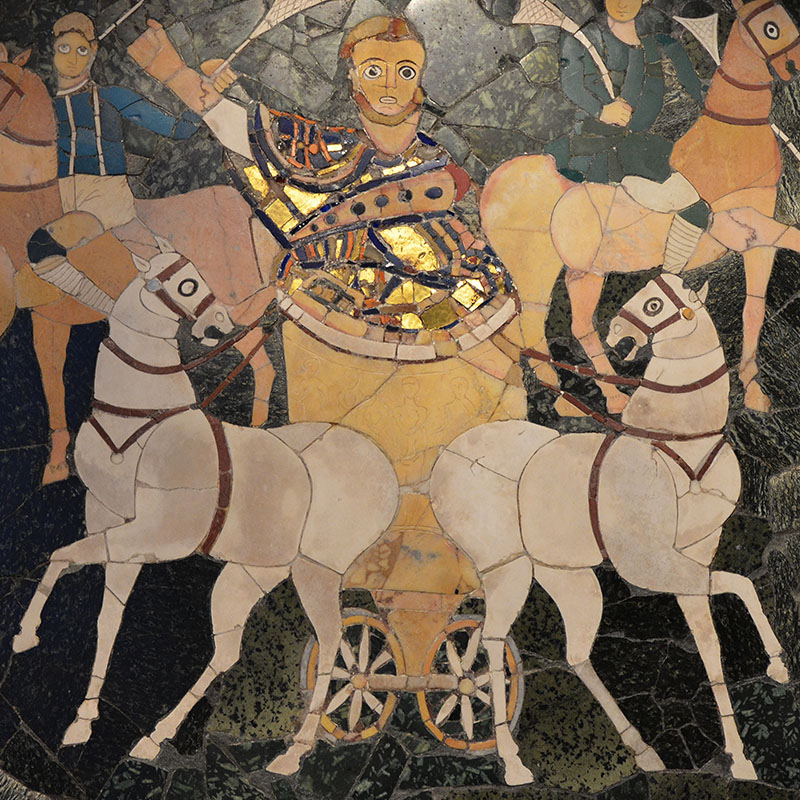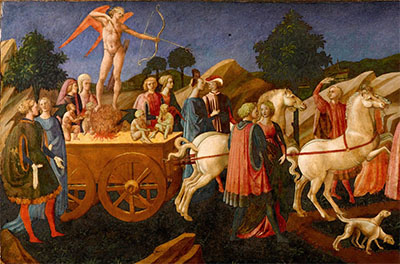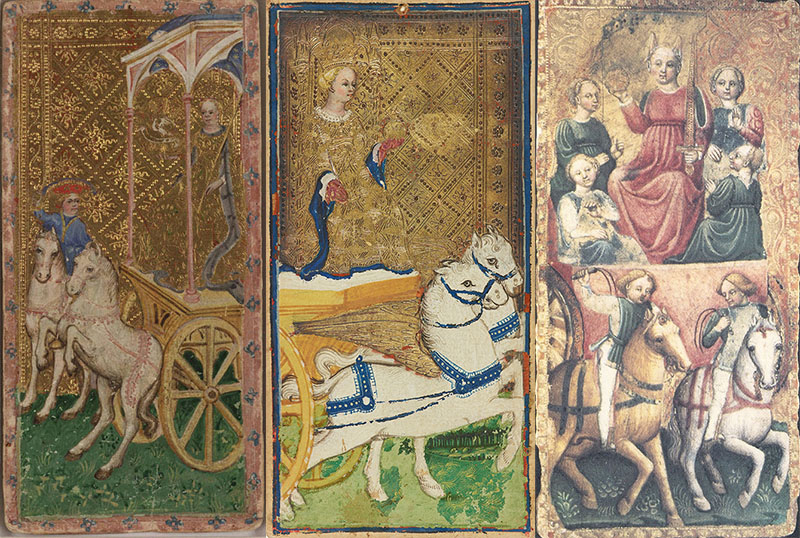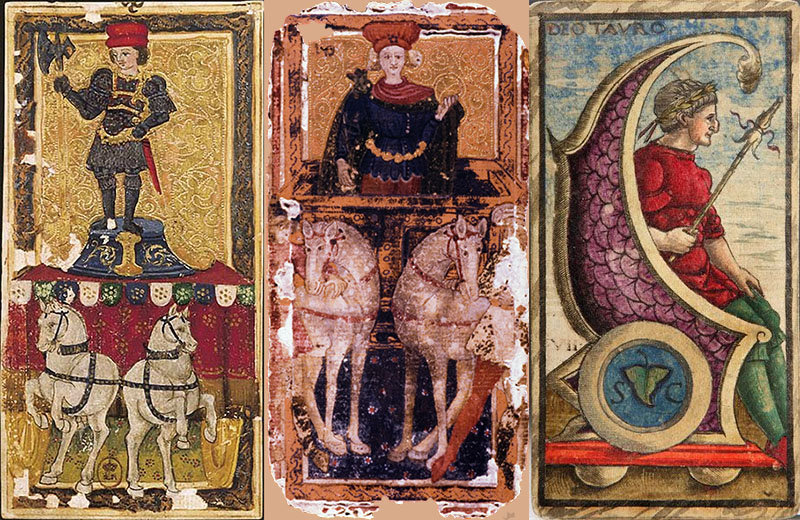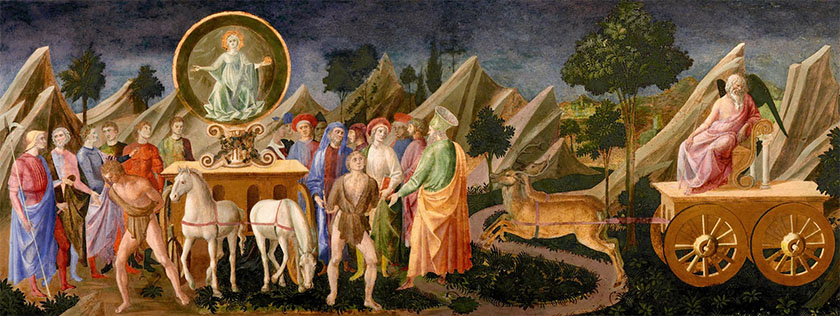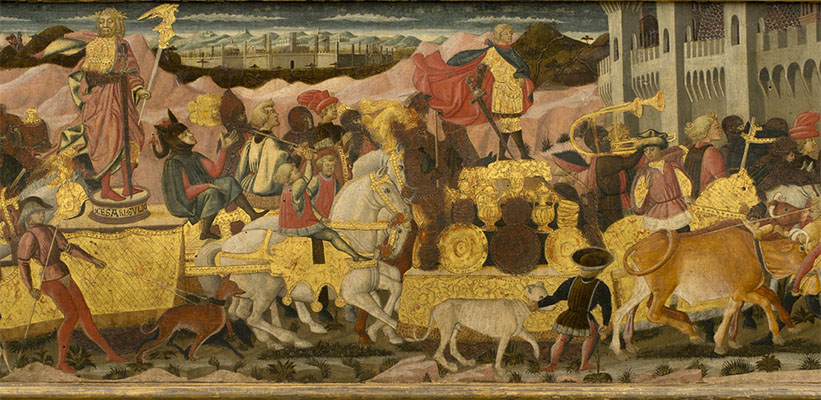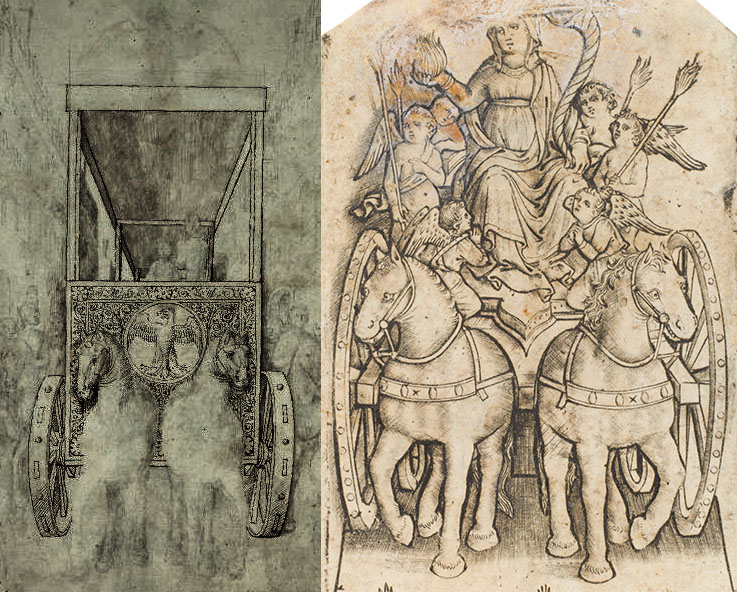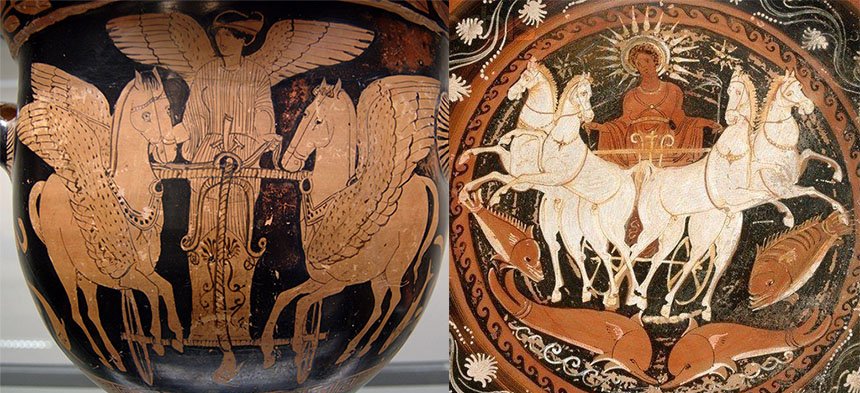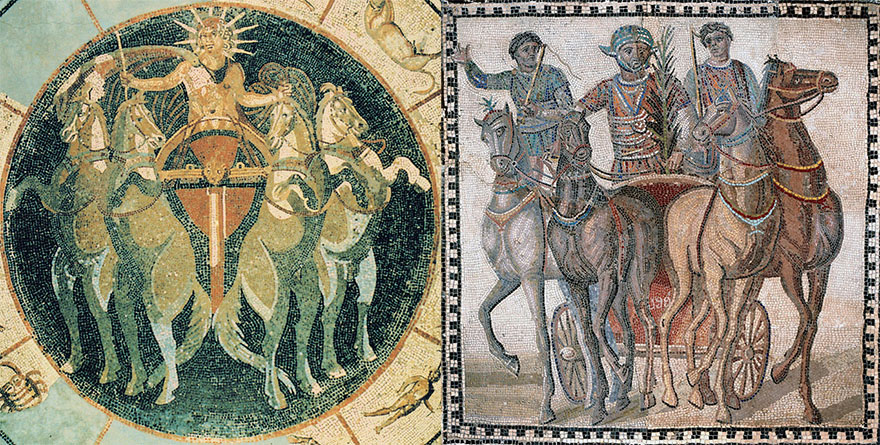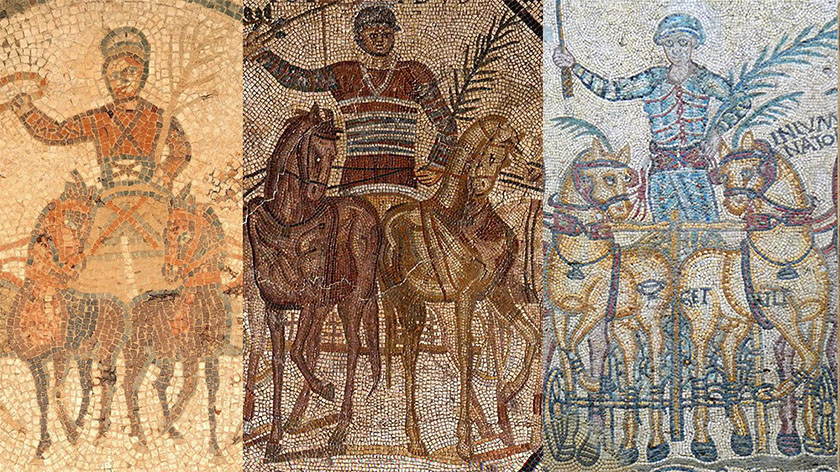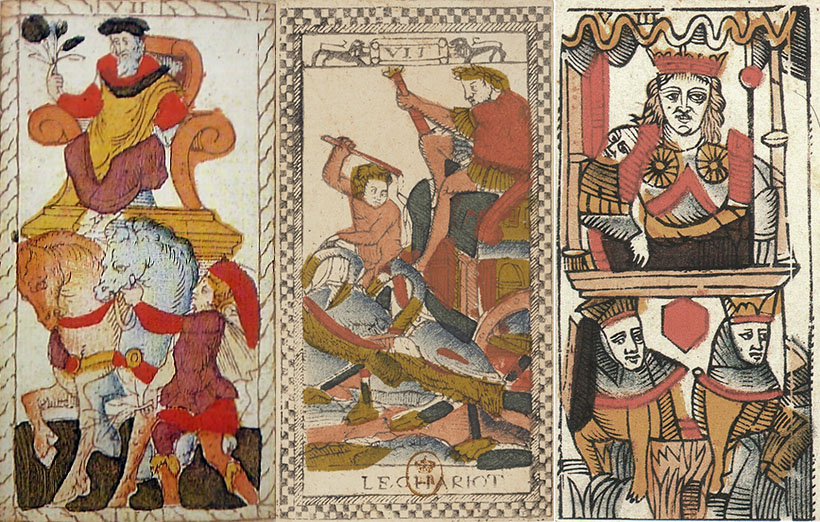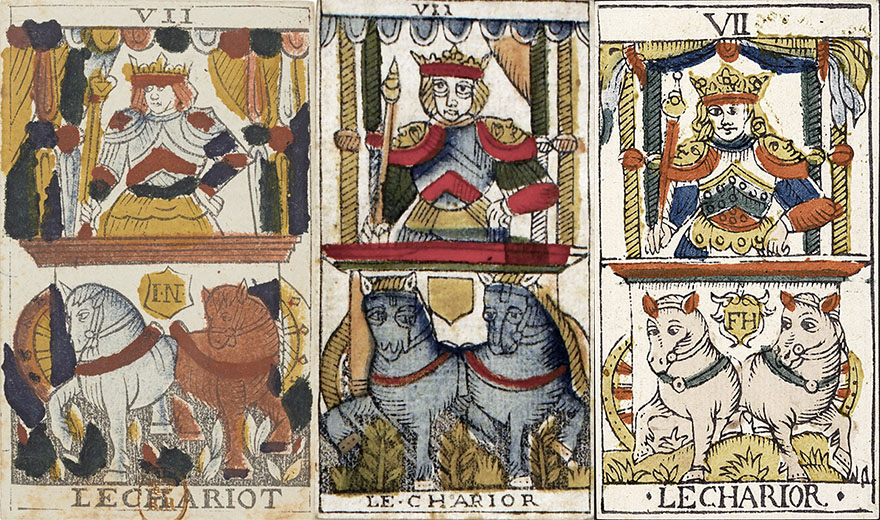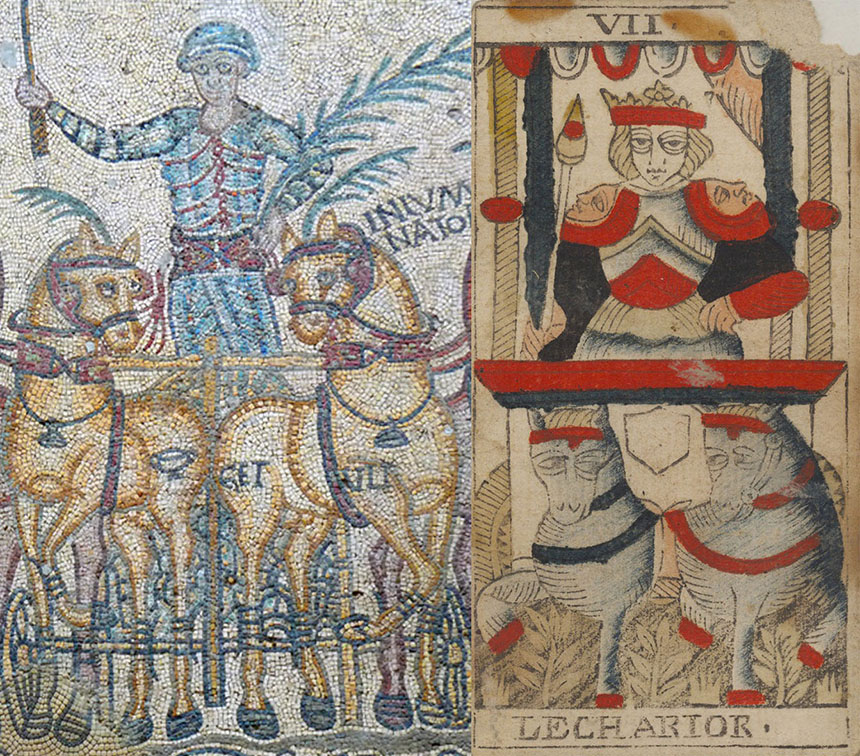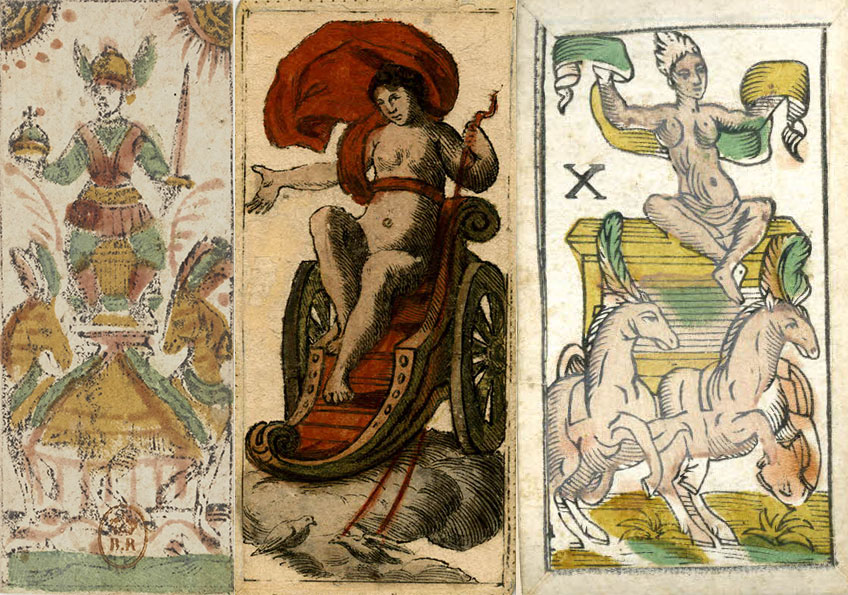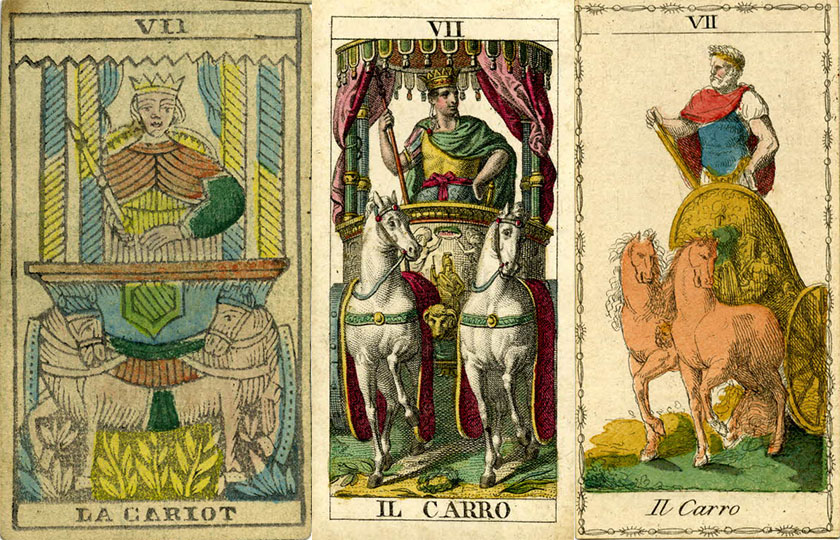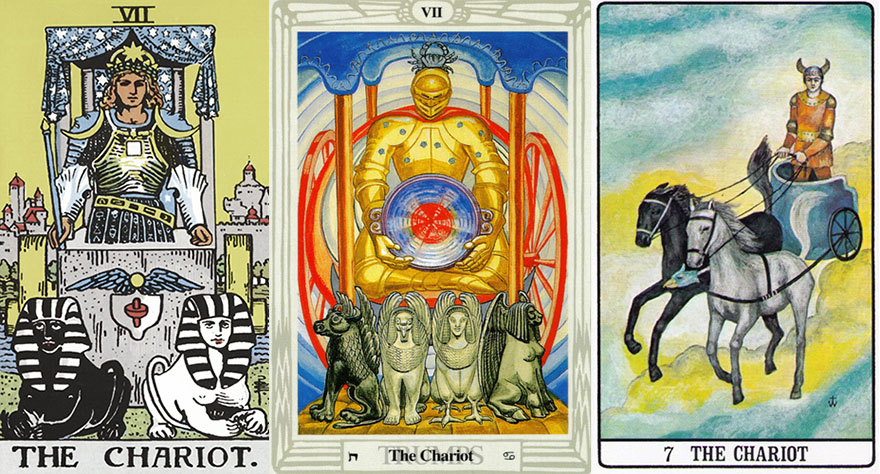THE TAROT WHEEL
LO CARO TRIUMPHALE - THE TRIUMPHAL CHARIOT
To start the page about the Chariot, I do not start with the detail of a Trionfi cart. Instead I show you part of Roman mosaic, situated in the basilica of Junius Bassus on the Esquiline Hill in Rome, representing the prefect of Rome, Junius Bassus, in a Biga, a chariot pulled by two horses. A beautifull image made long ago with historical links to the Tarot images. This we will discover here below.
The Chariot is maybe the card the easiest identifiable with the Trionfi cards. When Francesco Petrarcs wrote in the first half of the 14th Century his peom "I Trionfi", the poem that would later give its name to the Trionfi cards, he describes in one of the first verses the appearance of Love, the first of the Trionfi:
Four steeds I saw, whiter than whitest snow,
And on a fiery car a cruel youth
With bow in hand and arrows at his side.
No fear had he, nor armor wore, nor shield,
But on his shoulders he had two great wings Of
a thousand hues; his body was all bare.
And round about were mortals beyond count:
Some of them were but captives, some were slain,
And some were wounded by his pungent arrows.
This fiery car is the only appearance of a chariot in the Poem, but when artists started to make illustrations of the 6 Trionfi, all six of them were illustrated standing on a chariot. Another example later on this page.
Relatively many Chariot cards of 15th Century Tarot decks survived, in fact, it is probably the Tarot trump of which the most examples are available. So let me show them to you. We start with the oldest three surviving cards, all of them hand painted ones.
From left to right we have the Chariot of the Cary Yale Visconti, realised in 1441 at the occasion of the marriage between Bianca Maria Visconti and Francesco Sforza, the Chariot of the Visconti Sforza Tarot, realised in the early fifties of the fifteenth Century, maybe at the occasion of the Peace of Lodi in 1454 and the Chariot card conserved in the playing card museum of Issy-les-Moulineaux, close to Paris in France. This card is attributed to Ferrara around 1455. There are only three cards surviving of this deck, the two other cards are conserved in the National Museum of Poland in Warsaw.
Right from the beginning the Chariot in the Tarot has been considered as a chariot of victory (il carro trionfale). The first thing we remark on these handpainted cards is that there are only women on the chariots, one woman on the Visconti Chariots and no less than five on the Ferrarees Chariot. Let us have a closer look at each of the cards. On the first chariot we see a young lady in a golden dress. A closeup of this card can be found here. On the dress several piumay (a crown transpierced by a branches of palm and laurel), the personal emblem of Filippo Maria Visconti. In her right hand she is holding a disk, with on the disk a dove standing on a banner in fromt of a wavy sun. On the banner is usually written "a bon droyt". This dove against a wavy sun is the pesonnal emblem of Gian Galeazo Visconti, first Duke of Milan and father of Filippo Maria Visconti. The woman represents probably Bianca Maria Visconti, daughter of Filippo Maria. The Chariot has a flat surface. The lady is sitting on something and she is protected against the sun by a canopy. The wheels of the chariot have eight spokes each. A man is guiding the two white horses. The triumphal chariot reminds me here to the triumph of Chastity, the victory of a person over his lust and desires.
On the next card, painted like the first one by Bonefacion Bembo, we have exactly the same lady on the chariot, Bianca Maria Visconti. A closeup of the card can be found here. Again the wheels seems to have eight spokes. The chariot has like the previous one a flat surface and the lady is sitting on someting. This time there is no canopy. On her golden dress the wavy Visconti sun. The chariot is being pulled by two white winged horses, a symbol of strength and freedom. They do not need a guide anymore, they know were to go. In the hand of the Lady a golden orb of power surmounted by a cross. Her victory is consolidated, Bianca Maria is now the Duchess of Milan.
On the third card, the Lady in the central place also has an orb of power. In her other hand a sword that she holds upright, like the Virtue of Justice. Her hairdress is what we call a heart-shaped hennin, a style popular in the 15th Century under the ladies of noble courts. She is clearly a lady of a high rank. She is surrounded by four girls, that could be her daughters or servants. They are not sitting on a platform like on the previous cards, but they are rather represented sitting in the chariot. On the horses that are pulling the chariot se see two boys with a whip in their hand. They use the whip to speed up the chariot. It looks as if they are on a pleasure ride. What is very interesting is the composition of this card, are the two squares clearly separated each one from the other. On the upper square the five ladies sitting quietly together like in a sitting room, in strong contrast to the lower square where the two boys are whipping the horses in a tumultous ride. We are looking at the chariot more from the front than from the side, not a very usual position, but in view of the form of the card, where the hight is twice the width, this point of view is much easier to draw.
The next three cards show the same chariot, but this time they are occupied by men.. The first two chariots are represented from the front, so we see the horses, the chariot and the occupant of the chariot. On the third card we see the chariot from its side, with no space left to draw the horses. The first card is from the so-called Charles VI Trionfi deck, made probably in the early sisties of the 15th Century. The second card has approximately the same age, maybe slightly younger and comes from the Trionfi deck of Alessandro Sforza. The third card is not a Trionfi card, but belongs to the Sola Busca deck, a printed hand-cloured deck dated to 1493 using the same structure and number of cards as the Trionfi decks.
As stated above, the first two cards show the chariot from the front. On the chariot a man in armor with a poll-axe in his right hand, a weapon often used by knights in ground combats. His left hand is resting on his sword. The hat he is wearing is typical for the Fiorentine upperclass. He is standing on some sort of small pedestal on a chariot covered with a large ornamental cloth. The border of the chariot is ornamented with shields covered with seven dots. We see the same seven dots all over the red cloth that covers the chariot. The dots make us think of the Fiorentine Medici family, who has a similar pattern as coat of arms. The chariot is drawn respecting the rules of perspective,so both wheels we see from the inside. The chariot is pulled by two white horses. The whole scene is clearly the victorious entrance of a noble knight, probably after winning a battle.
The Tarot of Alessandro Sforza is a lesser known Trionfi deck of which 15 cards survived. They are conserved in the Castello Ursino in Catania, a town situated on the Italian island of Sicilia. The deck is called the Tarot of Alessandro Sforza, because on the shield of the Page of Swords of this deck we find an hyraldic symbol of Alessandro Sforza, a symbol he was using when he was lord of Pesaro. The Chariot looks now like a case in which the young noble man is staying. In his left hand he has the same orb of power as we have seen on the Visconti Sforza deck and on the cerd conserved in Issy-les-Moulineaux. Next to the each of the two horses a man who is guiding them. The young noble man is wearing exactly the same hat as on the previous card. Also the drawing style is very similar, the card could have been made in the same workshop (by the way, the World cards of these two decks are identical). On the ground we see some small flowers, representing probably the flowers that the crowd has thrown to this victorious person. On the upper left corner of the card we see the number 10, but this has probably been put later on the card.
The Chariot on the Sola Busca deck is one of the rare cards of this deck that conserve the same symbolism as the Trionfi decks, a triumphal chariot. Here we see the chariot from the side. All trumps of the Sola Busca deck depict ancient Roman heros and this card is no exception. On the card we see Deiotarus, a leader of an ancient Celtic tribe in Galatia, a region in the center of the actual Turkey. Deiotarus was a strong ally of the Roman statesman Pompey the Great, in the last century before Jesus Christ. He is wearing a typical Roman victory crown, made of laurel leaves. Even while using the same symbol, a triumphal chariot, the drawing is not at all in the same style as other decks. The same counts for the Mantegna print (not shown here) that show Mars in a triumphal chariot, this time from the front, but without horses. Let us have a look at the chariots that come to us on sheets or sheet fragments.
We have two entire cards and two fragments. All of them date from approximately 1500 plus or minus some (tens of) years. We have from left to right a fragment of the Budapest sheet, a fragment of the Cary sheet, the Chariot of the Rosenwald sheet and the Chariot of the Rothschild sheet.
The chariot depicted on the Budapest sheet, probably originating from Ferrara, reminds us to the chariot on the card conserved in the Issy-les-Mousineaux museum of playing cards. Here also we have several persons in the chariot. In the center of the group a winged person. The form of the chariot is like a cup with the group sitting inside like on the card of the Issy-les-Moulibeau museum. The horses are in a strange position, they are drawn from the side as if they were parading in front of the chariot.
The bottom part of the Chariot on the Cary sheet, probably originating from Milan, looks very much like the Chariot of the Tarot de Marseille. Even the shield on the front of the chariot is there. Even the ground on which the horses are walking looks like a typical TdM card. We see both wheels from the inside and the horses are touching each other with their backside. Both are lifting one leg, exactly as on the chariot of Junius Bassus at the top of this page. On the top of the card we see, like on the Cary Yale Visconty deck, a platform and a canopy on the chariot. The person on the platform is standing or sitting, we can just see his shoes and the bottom of the two front poles of the canopy.
The Rosenwald Chariot, probably originating from Bologna or Florence, is a mixture of the previous cards. A crowned king is holding an orb and a sword in his hands (like on the card of Issy-les-Mousineaux). He is standing inside the chariot (like on the chariot of Alessandro Sforza), and the horses are drawn from the side (like on the Budapest sheet).
The Rothschildt chariot, originating from Bologna, looks a lot like the Charles VI chariot. In the hands of the victorious person the same orb and sword as on the Rosenwald sheet, and on the front of the chariot a shield with a hyraldic symbol (le fleur de lys) as on the Cary Sheet. The chariot is very elaborate, and the man is standing or sitting on some sort of pedestal. On his helmet he has two wings. The position of the horses is also very similar to the Cary sheet. In the upper corners two suns as ornament. The Rotschildt sheets are the oldest example we have of Tarocchini cards.
After this tour of the representation of the Chariot on the 15th Century Tarot ancestors, let's have a look at the triumphal chariot as illustrated in early Renaissance Art. Here below two paintinsg of the Fiorentine painter Lo Scheggia, the first one depicting the Triumph of Fame and the Triumph of Time, and the second one a triumphal parade.
We see the preference of depicting the triumphal chariot from the side. Especially in triumphal parades, where we have a long line of people and chariots, we allways see the chariot from a sideview. We also remark that on all chariots there is a platform, with most of the times some elevated structure on which the victorious person is standing or sitting. This elevated structure is necessary so every spectator can see this victorious person very well. These victory chariots are very nice, but, except for the Visconti chariots, they don't look at all like the chariot on the Tarot decks, so we have to look elsewhere to find the real source of inspiration. Several websites suggest the two following drawings as probable source of inspiration for the chariot on the printed decks. The left one is a sketch from the Venetian painter Jacopo Bellini, made in the middle of the 15th Century and the right one is a drawing from Maso Finiguerra, a Fiorentine painter. This drawing is like the previous one created in the middle of the 15th Century.
The drawing from the left is from a sketchbook of Jacopo Bellini. The sketch is not finished and only some parts of the sketch are reinforced by ink. The contrast has been extremely exagerated by me, to allow to see some details of the sketch. The sketchbook is conserved in the British museum. The sketches in this sketchbook faded almost completely away. The second drawing (in fact a very early print) is representing the Triumph of Faith. What is very interesting on these drawings is that the lower half of both of them is identical in composition. The wheels are seen from the inside, both horses have a identical posture, with the outer front legs lifted up. On the Cary Yale sheet this part is also identical. The oldest of the three is the sketchbook of Bellini. The sketch is probably made before 1450. However, this was his personnal sketchbook and it is doubtful that other artists of the same period, like Maso Finiguerra, were inspired by this sketch. So the conclusion is clear, there must have been a common and older source of inspiration. Let us have a look at the history of the chariot as depicted in art, and concentrate us on chariots depicted with a frontal view. Let us start with some Greek artists. The ancient Greek loved pottery. Lots of them survived time and many of these are beautiful decorated, often with representations of the Gods.
On the left we have the Goddess of the Wind, Eos, standing on the chariot with which she is riding the skies. On the right side we have the God of the Sun riding his sun wagon. The left image is on the outside of a vase, the right one on the inside of the bowl. We see that the frontal view of the chariot is very well adapted to confined spaces and that the resut is a very dynamic picture. The vase and the bowl date to approximately the 5th Century before Jesus Christ.
The preferred art of the Roman culture was the mosaic. A mosaic was easy to clean and the colours would not fade away. Roman Gods were a rich source of inspiration. But also daily life and the games in the arena were a very rich source of inspiration for the Romans. Here below two examples, the left one with Apollo, the God of the Sun, and the right one the victorious winner of a chariot race.
The Roman God Apollo is depicted almost identical as the Greek God Helios. Roman culture was largely inspired by Greek culture and the Romans did not hesitate to copy Greek Art. The image of the winner of the chariot race has many similarities but the overall picture is less dynamic. The horses are calmer and each of them lifts one leg. We remark the similarity of the two inner horses with the chariots of Bellini and Finiguerra, and with the Chariot on the Cary Sheet. Is this the source of inspiration for the Chariot in the Tarot in a frontal view? The Mosaic is from the 3rd Century Spain and can be seen in the Museo Archelogico Nacional in Madrid. I'll show you three more mosais, focussing only on the inner horses of the quadriga.
The first mosaic has been found in England in a Roman villa near Rudstone, East Yorkshire, dated to the 4th Century. The second Mosaic has been found in Trier, Germany, is dated to the 3rd Century and conserved in the Rheinisches Landesmuseum in the same town. The third on is part of the "Mosaico de los Aurigas" found in Mérida in Spain and is dated to the 4rd Century. It is conserved in the same town in the National Museum of Roman Art. What we can see is that the Romans had a very standarized way in representing the chariot in a frontal view. These are only some examples, there are several more mosaics of this kind and they all have exactly the same composition, there existed clear rules how to depict the winner of a chariot race. The Roman Empire extended all over Europe, and we can find this kind of mosaics in Italy, Spain, Germany, England, France, to be short, anywhere where the Romans imposed there civilisation. So artists like Bellini and Finiguerra as well as card makers like the ones who made the Cary sheet or the Rothschild sheet had access to these images and they could have been inspired by this composition.
So after these Roman mosaics, let us go back to the Tarot cards and have a look at some cards from the 16th to 19th Century to see if they share the same source of inspiration, or if they found their inspiration elsewhere. We start with the oldest known French Tarot cards.
From left to right the Chariot of the Tarot decks of Catelin Geoffroy (1557), the early 17th Century anonymous Tarot of Paris and the mid 17th Century Jaques Vievil. The first two decks do not follow exactly the Tarot tradition in their images and the Chariot confirms this. They are still chariots, like all standard Tarot decks, but the way the chariot is pictured, does not adhere to the Tarot tradition as we know it from later French TdM decks. I will not try to describe the symbolism of non standard cards, but the cards are presented as they are, as a proof that the Tarot cannot be reduced to only the TdM standard..
The Chariot of Jaques Vievil however is much closer to the traditionnal TdM representation of the Chariot. The card looks a lot like a simplified version of the Tarot of Alessandro Sforza, with the horse heads replaced by human heads. The card reintroduces the canopy, allready existent on the Visconti decks and on the Cary Yale sheet. The horses lift one of their front legs like on the Roman mosaics, the hind-legs are not visible any more. Like on the Cary sheet there is a shield on the front of the chariot. The Vievil Chariot is an introduction to the Chariot of the Tarot de Marseille. Here below three of these TdM Chariots, the unique Paris made 1659 Jean Noblet, the 1701 Lyonese Jean Dodal, oldest surviving type I TdM and the 1718 François Heri, a Swiss made Type II TdM.
Except that the horses are real horses again, the TdM cards look a lot like the card of Vievil. The drawing style changed a little bit in the three decks, but in detail they are identical. On the lower half of the cards we see the chariot pulled by two horses. Both horses are lifting one front leg. On the Chariot of Jean Noblet we still see one of the hind-legs of the horses, on the two other cards they disappear completely. Both wheels are partly visible and can be seen from the inside. On the front of the chariot a shield with on two of the cards the initials of the engravers, IN for Jean Noblet and FH for François Heri. On the upper half a victorious prince, with one hand on his hip and a scepter in the other one. What is more surprising, all these details are virtuelly identical to the Roman mosaics I showed you before. To illustrate this even better, here below I will compare a detail of the 4rd Century Aurigas mosaic from Mérida with the 1713 Lyonese Type I Tarot de Marseille made by Jean-Pierre Payen.
The ressemblance of the two images is striking. The posture of the horses, the posture of the victorious person in the chariot, even the way he is putting his hand on his hips and his facial axpression are the same. For me there is no doubt, the TdM Chariot, the Chariot on the Cary Yale sheet, the Chariot of Jaques Vievil, the chariot drawn by Jacopo Bellini, the chariot created by Maso Finiguerra, all of them had the Roman mosaics as a common source of inspiration. These mosaics were standarized in form and existed on many places all over the Roman Empire. So they were accessible to any artist and card maker with historical interest.
The Italian cardmakers from the region around Bologna and Florence resisted against this TdM standardization. The Tarocchini and Minchate decks lived their own live. Here below three decks from Bologna, from left to right a early 17th Century standard Tarocchini Chariot, the 1668 Mitelli Chariot and an early 17th Century Chariot of a Bolognese Minchate deck.
The standard Tarocchini Chariot is identical to the one appearing on the Rothschildt sheet. the horses follow the tradition of the Roman mosaic, the victorious prince is depicted as on the Chariot of the Issy-les-Moulmineaux museum and the Chariot of the Rosenwald sheet, with an orb and a sword in his hands. Both other Chariots are non standard. On the Mitelli Chariot a naked woman sitting on a chariot without horses. It looks as if the Chariot is standing on a cloud. We only see two birds, probably doves, sitting in front of the chariot at the place of the horses. On the Minchiate Chariot also a naked woman, now sitting on an elevated platform on the chariot. Two horses are pulling the chariot, apparently in a fast ride. Like on the Tarocchini card the horses have red and green feathers on their heads.
The Italian Tarocco cards follow mostly the TdM tradition. Here below some examples, From left to right a Chariot from a deck made in the late 18th Century by a certain Rossini in Torino, then the Chariot from a deck designed in the early 19th Century by Della Rocca in Milan and at the right a Chariot probably made in the Napoleonic time in Milan.
The first two cards are typical TdM style cards. The card designed by Della Rocca is thanks to new printing techniques much more elaborate than the other TdM decks, but it conserves in essence all characteristics of the TdM Chariot and thus of the chariots on the Roman mosaics. The third Chariot is from a deck called the Tarot of Lombardy. It is influenced by the war campaigns of Napoleon in Northern Italy that took place in between 1798 and 1800. The style is very sober and only the essential elements are conserved. Remark however, that the two horses keep exactly the same position as on the card designed by Della Rocca.
With the rise of the influence of the Golden Dawn on the Tarot, most if not all o its historical design traditions disappeared, or faded so far away, that they became unrecognizable. From left to right we have here three Chariot cards designed under the guidance of Golden Dawn occultists. The occultists behinds the three decks are from left to right Arthur E. Waite, Aleister Crowley and Israel Regardie.
The most influential of the three is without any doubt Arthur E. Waite. He kept some elements of the TdM Chariot, but introduced many other symbols. He rejects the northern Italian origins of the Tarot and replaced them with Egyptian ones. Aleister Crowley and Israel Regardie on their turn break all links, that were eventually left, to the classical origins of the Chariot.
And here we end our page about the development of the Chariot of Victory. On the Visconti cards the Chariot symbolizes the victory over ourselves, on later decks it simply symbolizes victory. The card had some design changes over time, to cristallize finally in the model best represented by the TdM cards, a model that copied almost entirely old 3rd and 4rd Century Roman mosaics representing the winner of a chariot race.
